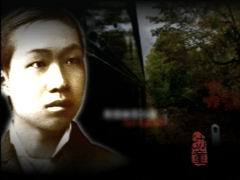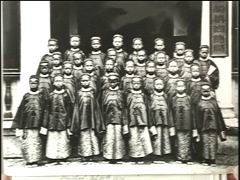Source: CCTV.com
08-14-2006 16:00

In Washington, DC, Tang Shaoyi met with self-funded Chinese students there. On With a his gloomy face, Tang made no efforts to conceal the failure that he encountered in this trip. The reality he had coame to terms with {was that} a weak dynasty could never have a real say in its own diplomacy.
During Tang's visit to the U.S., the situation in China changed acutely. Following the death of the Empress Dowager Cixi, the Guangxu Emperor Guangxu, Puyi was enthroned as the Xuantong Emperor Xuantong at a merely threeyears of age. Faced Wwith the inauguration of Zai Feng as Regent Zaifeng and the political downfall of Yuan Shikai, Tang lost not only his name, but also a clear vision of his future.
Three years later, the 1911 Revolution broke out. And Yuan Shikai rose again. His top concern was to negotiate with the uprising Southern troops in order to fulfil gain his the coveted of the presidency of the new Republic. This was the situation when Tang was commissioned for to undertake the peace talks with the Southern troops.
As the representative of the Qing Administration, Tang Shaoyi was backed up by the proposal by Yuan Shikai for a Constitutional Monarchy of Yuan Shikai, but he himself was for republican democracy.

On December 8, 1911, Cai Tinggan, a member ofwho was on the staff of Yuan Shikai, wrote to Morrison, a journalist with the Times that Tang Shaoyi had had his queue cut in his train compartment. What followed had never happened in the Qing history. Tang arrived in Shanghai, a top-rankinged royal official of the Qing empire, dressing in a suits, ties, French hats and coats, with no queues. In In Shanghai, he played a vital role in the abdication of the last emperor of the Qing dynasty, in the establishment of a democratic constitutional polity and the founding of the Republic of China.
The story was not yet over. In the summer of 1919, the former admirals, Wu Yingke and Cai Tinggan, came down to Shanghai on business, and were invited by Tang to a dinner {with}, Zhong Wenyan and other former Boy Students. To everyone's surprise, the dinner venue turned out to be next to the preparatory school they attended prior to their departure for America. All those scenes of old times now felt just like yesterday, and they decided to take a reunion picture. They added up their ages: 1000 years in total. The picture was then named "Millennial Picture".
These students were now in their sixties. At In the same year, the May 4th Movement for the modernization of China broke out. Unfortunately, these graduates from the very country of modern science and democracy were never consulted by the fanatic young activists that who were {in pursuit of such ideals. Despite their fluent English and Western lifestyle, they were not only degraded as the an unwanted legacy of the Qing Dynasty, but also despised as underlings to the West. The time seemed to have come that for themy should to fade out in of Chinese history.
Another 20 years passed.
Tortured Caught in the crossfire of the Anti-Japanese War in 1940, no one in China seemed to care much about theose U.S.-trained. Dr. Lafargue, a professor at Washington State University, came to China to collect the stories about these long forgotten people.
At a restaurant in Shanghai, Dr. Lafargue invited the surviving Boy Students to a dinner.
Two years later, Dr. Lafargue's book-- China's first hundred was published by Washington State University Press to be as the first publication on this topic. On Tthe head title page of the book reads, "To all that great band of returned students who have tried to bridge the gap between China and the western world."
The book failed to revive any interest in these students and their education in the United States 50 years earlier. In 1942{,} oOn the brink of annihilation in the common threat of the World War II in 1942, no one was interested in becoming nostalgic about the doomed modernization of China. The Boy Students were once again ignored.
Thirty years passed by. In 1972, the stagnant relationship between China and the US underwent a dramatic improvement in 1972. At In that year, Gao Zonglu, a Chinese scholar based in the U.S., published an article in the local press to commemorate the 100th anniversary of the first Boy Students' arrival in Connecticut. With that article, Mr. Gao started a research that would take him decades.
Mr. Gao discovered that Mrs. Warner's grandfather happened to be the headmaster of Zhan Tianyou, who had posted them the highly valued pictures of the construction work of {the} Beijing-Kalgan Railroad.
